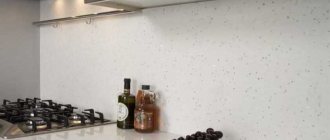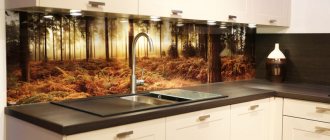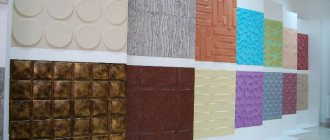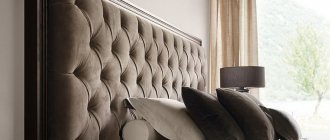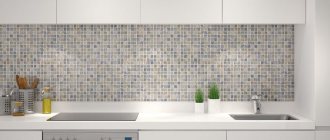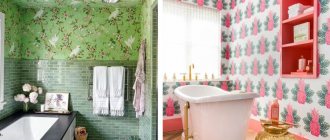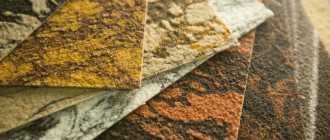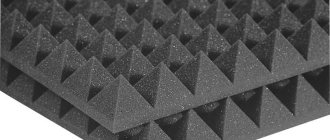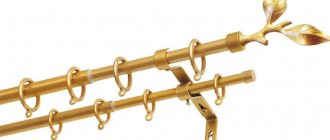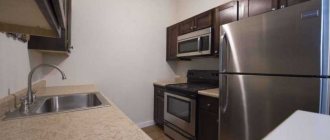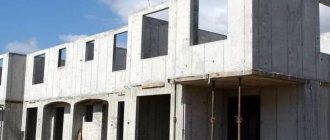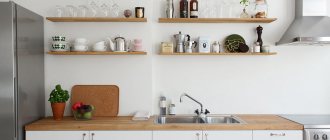The kitchen can safely be called a special room that requires a careful approach to design. Ceramic tiles are used less and less for this purpose these days. New types of materials are increasingly replacing this type of finishing. PVC panels for the kitchen are one of the solutions that are used especially often today. Folding plaster, uneven surfaces, heaps of rubbish during repairs, inviting specialists for finishing - this can be avoided if you use PVC tiles for the kitchen walls. All wall defects will be masked, and the owner will receive a room created in accordance with his taste preferences.
Finishing the kitchen with PVC panels is an excellent alternative to traditional materials: tiles, plaster or wood
Kitchen design with PVC panels (photo selection)
For quite a long time, it was believed that plastic panels were a solution for decorating economy class premises. It was common to think that plastic has a rather poor appearance, has a short service life and quickly loses its good appearance. But today, all of the above can only be attributed to the most budget-friendly types of PVC wall panels for the kitchen.
Plastic lining is an excellent solution for finishing the kitchen ceiling
The design and pattern of the coating plays a very important role when covering walls. It should have a beautiful appearance, be original, and also complement the style of the room.
It is desirable that all communications and pipes are hidden. They can be neatly tucked behind the grille without disturbing the overall appearance of the kitchen. If you plan to hide the wiring, you shouldn’t wall it up tightly. It is best to try to ensure access to it and make a small door in the panels for this.
PVC panels can cover all the walls of the kitchen or use them only to decorate the apron
When decorating a small room, it is best to choose light-colored coatings. A light tone will visually increase the space and make the room wider. You should not choose too bright colors or large patterns. It is best to use such solutions for decorating an apron. Any colors can be combined. But at the same time it is necessary to control that they are combined. To do this, you can look at photos of the design of kitchen decoration with plastic panels on various Internet resources. The shades of the plastic base can be changed using self-adhesive film.
Narrow panels with a glossy surface - a suitable option for a high-tech kitchen
The main task is to choose the appropriate option and size of the covering, carry out the correct installation and ensure that the material is harmoniously combined with the pieces of furniture.
Advantages and disadvantages of panels
I would like to say right away that such a panel is not very picky in installation. Therefore, there will not be large costs here either. And let’s dispel the myth that it is not beautiful and cheap in appearance. There are a lot of different panels, from very cheap to expensive (almost the same cost as tiles). Their designs are also very different - from snow-white to PVC with a floral pattern or a water world. Therefore, if you choose the right color scheme of plastic, your kitchen will turn into a real masterpiece.
The plastic panel can be from one meter to three meters long. And the width can vary from ten to 25 centimeters, depending on wishes (there are dimensional exceptions, about 30-40 centimeters). At the same time, if you want to find both a 20-centimeter strip with red flowers and a 15-centimeter strip (to join beautifully), this will be very unlikely (unless you are looking for a pure white color).
It is worth noting that plastic panels can be cut and adjusted to length.
In order to make the right choice, it is worth understanding all the advantages of this material:
- Water resistance. Finishing the kitchen with plastic panels is good because no moisture, steam or water can damage the appearance of the panel. Even if your neighbors flood you, the plastic will not darken or fade and will remain the same as on the first day. You can easily wash stains off it with soap.
- Easy to care for. The kitchen will be easy to wash and clean using any means - water, soda, chemicals.
- Easy to install. Finishing with panels is very easy to do and does not take much time. Even a novice specialist will be able to perfectly install the plastic layer so that it looks like a custom order.
- Low price. PVC panel has a low cost. And, accordingly, it will help save money on other finishing elements. Moreover, not only is the plastic layer cheap, but so is its installation. No special tools, mixtures or large drills are needed.
- The panel is not a conductor of electric current. This will help protect the kitchen and its visitors from unwanted moments.
Related article: How to calculate curtain footage: correct measurements
In principle, there are enough positive qualities to choose such material. But do not neglect the disadvantages, which are also important. Let’s be honest, although plastic doesn’t have many disadvantages, they are very important:
- Easily susceptible to mechanical damage. Any panel can break, choke and crack if you put pressure on it or put something heavy on it. This is a big disadvantage for the reason that it is necessary to approach transportation, installation and care with the utmost care. If a champagne cork suddenly flies into a panel wall in the kitchen, a dent will most likely remain clearly visible on the panel. When choosing PVC strips, you should pay attention to all the corners of the strips and their surface. It happens that during transportation to the store they are already damaged.
- Fire hazard. The PVC panel is very easy to burn. If you lean a very hot frying pan against it, the plastic can melt. This will be very damaging to the appearance of the kitchen. Although, if you treat every element of the interior very carefully, then this point is not so significant.
Just two disadvantages with so many positive aspects make plastic very popular for finishing kitchens and other rooms. Therefore, when choosing the material with which to decorate the walls in the kitchen, paneling is a very good option.
What are PVC panels
PVC kitchen panel is a material based on polyvinyl chloride, which contains a solid softener in minimal quantities. The material is of high quality, but at the same time it is completely safe. PVC is moisture-resistant and heat-resistant. The material is very simple. And thanks to its low weight it is very easy to install. Thanks to its longitudinal honeycomb structure, the plastic has a hollow interior that enhances heat and sound insulation. And if you use photo wall panels in the interior of the kitchen, you can quickly and radically change the room.
PVC panels vary in shape, size and method of processing the decorative layer
Panels are considered one of the most suitable materials. They can be divided according to the type of material that is used as a basis. Plastic models have advantages and disadvantages that need to be taken into account when choosing.
The average service life of plastic panels is 10 years. In reality, products can last much less or 2-3 times longer - it all depends on the operating conditions
Cladding technology
Each kitchen contains more than one decorative element. Plastic finishing, for example, can only be done above the stove and above the sink. Or the plastic layer will be completely above the countertop. In any case, in addition to plastic, wallpaper, tiles, decorative stone, etc. can be used. You can make sure that one wall is wallpaper, another is tiled, the third is made of stone, and on the fourth there will be shelves with dishes. Any option will do. But depending on what is already planned for the kitchen, the methods of installing plastic strips will vary.
Article on the topic: Corner wardrobe in the bedroom: types, contents, sizes, design
- The first method is to trim horizontally with stripes. This method can only be used if not the entire kitchen will be finished with plastic. For example, PVC will only lie above the countertop and up to the hanging shelves. In this case, from 2 to 5 strips of plastic will be laid and they can be installed horizontally.
- The second method is vertical finishing. This method can be used to decorate any room. A full wall can be covered vertically with PVC strips and the result will be simply excellent. The kitchen is no exception; this method can also be used here.
Installation of plastic must take place on an existing frame. As in other cases with a frame, it is necessary to prepare the wall, make a wooden frame (first we beat the lower and upper planks, and then we adjust the vertical strips around the perimeter and the horizontal strips inside the frame). When the base is ready, you can lay insulation in its gaps to heat and sound insulate the room. Plastic finishing is done with minimal effort and loss from the corner of the room. If you start from the center of the wall, then you will have to cut the strip of plastic twice.
The PVC wall version is laid using guides. There are these types: F (for the beginning of laying, ending or corners), L (only for the beginning and end of walls), H (universal for connections, joints). There are also external profiles, corner profiles and skirting boards. Depending on the plane being processed, guides are also selected.
To install plastic, you do not need screws or nails. Each subsequent strip of plastic fits into the grooves of the previous one. To ensure tight connections, some parts can be joined using liquid nails, but this option is used in extreme cases. The wall type of processing is very simple, the processing of ceiling plastic is much more difficult. But this happens only because several people need to be involved in installing the panels on the ceiling.
Related article: Designation of sockets and switches on construction drawings and diagrams
I would also like to give a few tips for those who still decide to make a room in plastic on their own:
- when choosing a finish in a store, pay close attention to the quality of the strips themselves and their integrity;
- if you are faced with the issue of plastic for the first time, it is recommended to immediately purchase liquid nails, which will help to slightly improve the joint in difficult places;
- transport the material so as not to damage it. It is better to immediately cut the material in the store into pieces about 1-1.5 meters long. This will make transportation much more convenient;
- It is undesirable for the panels to be exposed to direct sunlight, so install them in rooms where there is not much sunlight;
- do not install heaters, light bulbs or other objects that heat up near plastic panels;
- Do not try to smooth out dents in the plastic. This is almost impossible to do, but it can damage the strip even more.
As a result of the article, I would like to wish every master great patience in working with such material. Make a detailed schedule and plan of what you will do and only then start working. For an ideal look, the walls should be as smooth as possible. If the room has sloping corners, then it is better to choose a different finishing option or initially level all the walls. Good luck in your endeavors!
The main advantages and disadvantages of PVC wall panels for the kitchen
The material used for manufacturing is PVC, which has a certain density. The main advantages of the material are:
- affordable price;
- ease of installation;
- a wide variety of colors and shades;
- resistance to moisture, penetration of microorganisms;
- safety and environmental friendliness;
- excellent noise insulation properties.
Finishing with plastic panels allows you to hide surface defects and do it with little cost.
A variety of textures and colors, combined with an affordable price, have made plastic panels one of the most popular ways to decorate a kitchen interior
The main disadvantage of the material is poor resistance to mechanical influences. The installed cladding must be handled with the utmost care.
Crazy hands: DIY plastic panels in the kitchen
Working with PVC panels is considered one of the simplest and most unobtrusive. Having selected and purchased plastic sheets, you need to prepare the remaining tools and materials: 1) for the frame - wooden slats or metal profiles; 2) construction stapler, special fasteners; 3) tape measure, small hacksaw, pencil, ruler, level.
For proper installation of corners and joints, you will need moldings - special plastic profiles. Installation begins from the corner of the room, creating a wooden or metal frame. Depending on how the panels will be positioned, the slats are mounted vertically or horizontally. The first panel is installed vertically, inserted into the corner profile with a side cut. The correct installation of this element will determine how smoothly all subsequent sheets will be installed.
You can, if necessary, change the direction of the masonry, ensuring proper zoning of the room. In some cases, wall panels can be laid with glue. In this case, the surface quality must be appropriate - it must be clean and perfectly flat.
Popular colors
Usually, when choosing colors for kitchen panels, traditional rules apply. For small rooms use light-colored material. It is preferable to use light colors - pastel or beige. Some designers, for example, claim that the blue tint spoils the appetite, while green and orange colors improve the appetite.
Finishing the walls and ceiling of the kitchen with white panels will visually expand the space and make it brighter
Panels with images of fruits, vegetables or simply delicious food will help improve your appetite and mood. Excessively large images may not be entirely appropriate for small spaces.
Finishing the kitchen with plastic opens up a lot of possibilities for creating original designs.
The cheapest single-color lining seems to be created for decorating a kitchen in the Provence style
Glossy panels with an unobtrusive pattern will come in handy in a modern-style kitchen
Large format sheet plastic is ideal for minimalism
Matte panels to match the set in a classic style kitchen
Characteristics of wall panels
If you decide to opt for decorative kitchen panels, then you should know about their types.
Manufacturing materials
Currently, kitchen wall panels are made from materials such as plastic, glass and wood boards.
- Sheet plastic panels for the kitchen are made from solid polyvinyl chloride. This is a high-quality and safe material that is easy to clean, lightweight and very durable. In addition, it is distinguished by its low price.
PVC sheet panels for the kitchen are available in various colors and can imitate brick, wood, stone, mosaic, etc.
PVC panels. Imitation tiles.
Advice! This material is poorly resistant to various types of mechanical stress. It is highly undesirable to place it near the hob. It is advisable not to use abrasive substances when caring for it.
- Glass. Wall panels made of tempered glass, called “skinali”, are one of the most common types of this material. Having appeared on sale relatively recently, they have already become very popular. They are made from special tempered glass with a thickness of more than 4 mm.
This material is able to withstand almost any mechanical loads and shocks, and is not afraid of both high temperatures and various detergents.
Absolutely smooth surface, easy to clean - just wipe it with a damp cloth from time to time. Unlike tiles, paint or wood, glass is very easy to clean from grease and any other contaminants that arise during cooking.
Advice! Since water spots remain on a glossy glass surface, this problem can be solved in two ways: by ensuring regular maintenance or by choosing a panel with a matte finish.
They sent it with photo printing.
When caring for such panels, you can use any household products, except for abrasive materials, which include hard brushes and metal meshes. Such a surface should also not be exposed to direct flame. In this case, you should maintain a distance of 7 cm between the gas burner and the wall panel. If the skins overheat (exposure to temperatures above 90 degrees Celsius), this will lead to damage to the design or the product itself.
- Tree. This material is the most expensive. For the manufacture of this type of cladding, various types of wood are used: alder, cedar, oak, etc. This material is mainly used for finishing offices, corridors and residential premises. For use in the kitchen, wooden sheets are treated with special agents that prevent them from swelling under the influence of excess moisture.
They come in the following types:
- Made directly from wood materials (fibreboard, chipboard) - their distinctive features are the laminated coating, which has a pronounced texture or a smooth surface using a wide variety of patterns.
Sheets made from particle board are not very durable and are prone to destruction due to frequent temperature changes. They are strictly not recommended for installation in rooms with high humidity, in particular in kitchens.
- When producing MDF boards, the pressing method is used. This material perfectly withstands high loads and is not afraid of moisture, and it is this material that is installed in kitchen areas. It has high heat and sound insulation properties, and is easy to install and maintain.
Kitchen wall panels made of MDF.
Dimensions
Sheet panels for the kitchen can be of two types: slatted and tiled.
- Stacked tile panels resemble ceiling tiles, being squares 98 by 98 centimeters wide. They can be used to lay surfaces in both a mosaic and a checkerboard pattern, which allows for the implementation of various design solutions.
- Stacked slatted panels are long planks, the area of each of which, depending on the type, is on average 3 meters, width - up to 30 centimeters, thickness - up to 1.2 centimeters.
How to choose the right PVC panels
When choosing panels for decorating walls in the kitchen, you need to consider the following recommendations:
- To create an original design, you can purchase unusual panels. For a high-tech style, an option with a metallized surface is suitable. For minimalism - a brick surface. Wood will be a great addition to the classics. Ornaments or images in vintage style are suitable for interiors in a classic style.
- The dimensions of the panels should be slightly larger than the apron area so that they can go behind the kitchen cabinets, sink, and stove.
- If you plan to install such panels near the hob, then it is best to purchase a base that is characterized by high fire resistance.
- It is best to choose design and color schemes in accordance with the size and area of the kitchen space. For a small kitchen, you can use a light base or patterns in small colors. A plain surface would look ideal, as would imitation wood with a matte surface.
Economy class includes panels with direct printing and plain ones without a pattern
Expensive models with lamination and 3D printing are approaching the price of ceramic and wooden competitors
Features of the color of PVC panels
The plastic panels also differ in the way they apply the pattern, since the base of the plastic itself is white. How do wall panels become colored?
- Using thermal film. When making such models, the PVC surface is treated with a special solution, and then covered with a film using a roller. This application of the top layer ensures the strength and durability of the product. The film covers both sheet and tile types of panels. Thanks to it, you can choose beautiful and unimaginably bright drawings. For example, mosaics can be made on thermal film. Panels with this coating are distinguished by a variety of colors and are superior in range to ceramic tiles. In the next photo, look at the kitchen design, where a plastic apron with photo printing on film is installed.
- Using direct printing. This type of coating differs in that the design is applied directly to the white panel, then it is treated with varnish and dried. They choose such models instead of the usual wallpaper - they look harmonious and add sophistication to the room. But the main disadvantage of direct printing is its sensitivity to mechanical damage. Using this printing method, mosaics, floral patterns and bright prints can be made. But products with a stone look or with a brick pattern are best chosen in the thermal film version. The photo below shows the kitchen interior, where simple panels with color images were used.
- Using lamination. Such a PVC sheet will be highly durable due to the fact that the top layer here is another “level” of plastic. Such wall panels will last a long time, and they can even be cleaned with chemicals. They are chosen when you need to decorate the apron area with the most reliable material. These models are produced in different colors, but their main advantage is the ability to order a pattern. If you want to decorate your work area with a fashionable image that resembles cracked brick or expensive stone, lamination will allow you to do this. Look at the following photo for an example of kitchen cladding with catchy and memorable panels.
As for the cost of different PVC products, sheet models with lamination are considered the most expensive. In terms of price, they can easily “catch up” with tiles. But panels with direct printing and thermal film will cost less.
When choosing PVC panels, focus on the strength and decorative properties of the products. For example, both sheet and tile models are suitable for finishing the apron area. If you need to save money, the best option for covering walls would be plain slatted panels. The glossy shine of the coatings will visually expand the space, and fans of the Art Nouveau style or laconic high-tech can choose products coated with a metal-like film.
How to panel
If you don’t know how to properly cover a kitchen with plastic panels, contact a specialist. Although in fact this process is extremely simple and often the owners of houses and apartments do such work with their own hands.
When installing PVC panels, special fittings are used - starting, corner and joining profiles, which give the finish a finished and neat look
Installation of panels consists of several stages. At the first stage, the walls are prepared. All protruding elements are removed from the surface and their surface is leveled. It is necessary to think in advance and determine the mounting locations for switches and sockets. Next comes the process of installing the frame, which is the key to the strength of the wall cladding. The frame can be made of wooden and metal slats. The latter option is considered the most durable and reliable. Wood slats and metal slats are attached according to the same principle.
Stage 1 – surface preparation
Stage 2 – installation of the sheathing
Stage 3 – installation of panels
The frame can be installed vertically or horizontally. The method is determined in accordance with the chosen method of installing the panels - vertical or horizontal.
Wooden slats or metal profiles are attached to the walls from floor to ceiling in such a way that there is a strictly vertical distance from the bottom to the top plank. You can use a building level or plumb line for measurement. The ideal option is a construction laser.
In order for the finishing with plastic panels to come out smooth and beautiful, the lathing must be aligned in the same plane
When the frame is ready, the final stage of work begins - attaching the panels. To do this, you will also need to use profiles on which the sheets will be attached. After installing the panels, you can begin finishing with baseboards.
Installation of panels begins with the installation of starting profiles
Using panels to decorate a kitchen can be called a simple, affordable and original solution. The material fits quite easily into any interior design and it is not surprising that today plastic is becoming one of the most popular building materials.
Installation of wall panels
The material can be attached directly to the wall only if its surface is perfectly flat. More often, a wooden, metal or plastic frame is used for do-it-yourself cladding.
You should have a supply of sheets, especially if you have chosen a complex wall design. Don't forget about the fittings: the finishing sheets are connected to each other by joining profiles and moldings.
Tools
- Roulette.
- Pencil.
- Mounting level.
- Scissors, stationery knife or hacksaw.
- Electric hammer drill.
Frameless cladding
Installation occurs in the same way as tiling walls.
- The surface is pre-leveled and primed.
- Apply glue with a notched trowel and press the panel to the surface. When using Liquid Nails, they are applied pointwise and along the edges in the form of lines.
- The strips are joined together, the outer panels are fixed with self-tapping screws.
The disadvantages of this installation method are obvious: time-consuming preparation of the walls is required. At the same time, the cost of installation increases due to the price of glue.
Frame method
You will need wooden slats or a metal or plastic profile to make the frame. If there is a lot of cooking in the kitchen, then the wooden planks can be treated with antiseptic impregnation, this will make the frame resistant to high humidity.
Sequence of work
- Wooden slats or metal (plastic) strips are attached to the wall with self-tapping screws or dowel nails. The direction of the planks must be perpendicular to the direction of installation of the panels.
- All pipes and other communications must be bypassed using a frame.
- To install the frame, use a plumb line or level. All angles must be right and the lines parallel.
- It is necessary to maintain a distance between the slats of at least 50 cm.
- After the frame is ready, fittings are installed: internal or external corners, finishing elements.
- If you need to install panels right up to the ceiling, then a ceiling plinth is attached to the top bar.
- The required length of panels is measured and cut. Plastic can be cut well with a knife or a serrated file.
- Installation starts from the corner. The side groove of the first panel needs to be cut off in order to fit the slab tightly into the corner element.
- After checking the mounting level, the panel is fixed to the frame using staples or screws.
- Subsequent strips are simply inserted into the grooves and attached to the frame.
- The last panel needs to be cut off with a wide protrusion.
- This panel is first inserted with a cut into the groove of the fastening element, and only after that - into the groove of the penultimate panel.
Using the panels, you can make an apron or walls to look like “wood.” To do this, the material must be installed horizontally. It, like panels of different colors, is joined together using connecting elements.
In this way you can decorate small rooms. Plastic panels are one of the best options for quick interior wall decoration in a Khrushchev-era building. The next video shows the technology of finishing a kitchen with plastic panels.
The same principle is used to cover a kitchen apron. The design in this case is developed taking into account the color of the countertop, furniture and ceiling. Below are photos of kitchens with an apron made of plastic panels.
